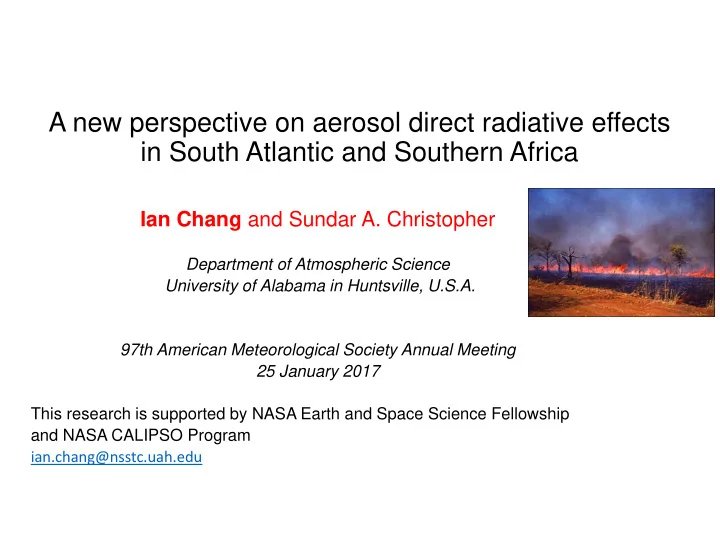

A new perspective on aerosol direct radiative effects in South Atlantic and Southern Africa Ian Chang and Sundar A. Christopher Department of Atmospheric Science University of Alabama in Huntsville, U.S.A. 97th American Meteorological Society Annual Meeting 25 January 2017 This research is supported by NASA Earth and Space Science Fellowship and NASA CALIPSO Program ian.chang@nsstc.uah.edu
Field experiments 2016-2018 Outline • Motivation Africa • Data and methods • Results S. Atlantic • Summary Zuidema et al. 2016, BAMS Biomass burning in Southern Africa http://research.metoffice.gov.uk/research/obr/ aerosol/safari.html
o Radiative effects of Motivation aerosol above cloud differ in magnitude Top of Atmosphere and sign when Cloud Properties compared to cloud- Aerosol Properties Surface properties free cases. Background-aerosol Background-aerosol =Negative radiative effect =Positive radiative effect o Current satellite aerosol product still deficient for providing Land global picture of Ocean aerosols above all surfaces.
Objectives • To develop an algorithm to retrieve aerosol properties above different scenes (clouds, ocean, land) using MODIS multispectral sensor. • To estimate the combined direct radiative effects of all scenes using radiative transfer calculations.
Objectives: 4 scenes in a case study MODIS-Terra on 25 August 2016 Aerosol: 4 3 1. Over ocean 2 2. Over land 3. Above cloud (ocean) Walvis Bay 1 4. Above cloud (Land)
Nighttime 532nm Total Attenuated Backscatter Aerosol cluster AOD retrieval and DRE calculations within elevated aerosol clusters Daytime 532nm Total Attenuated Backscatter Aerosol cluster
Spectral signatures Cloud only Aerosol above cloud (ocean)
Data and Methods 2. Input 1. Scene Identification 3. Look-up table • Radiance • CALIOP (aerosol) • AOD • Solar zenith angles • OMI Aerosol Index • COD • View zenith angles • MODIS (cloud, • Cloud effective • Relative azimuth angles aerosol, surface type) radius (ocean only) • Spectral surface albedo (land only) • Pixel heterogeneity • Aerosol properties • Aerosol properties Radiative Transfer Model Supplementary data information • CALIOP L2 (night and day): Aerosol clusters (>50km) 4. Output • OMI Aerosol index • AOD (MOD04_3K) in cloud-free conditions Instantaneous flux (Wm -2 ) • COD>4, cloud fraction=1 (MOD06) • • Visible spectral surface albedo (MCD43C) for land • SAFARI 2000 aerosol optical properties (SSA 550nm =0.91)
Results: AOD retrieval (cloud-free only) MODIS true-color cloud-free
Results: More AOD retrieval from 4 scenes Cloud-free cloud-free Above-cloud How do their direct radiative effects differ?
Results: Aerosol direct radiative effects (Wm -2 ) Ocean Land Aerosol -10 - 20 Direct radiative effect (cloud-free) = Background – aerosol Aerosol +150 + 50 (above cloud) +25 Wm -2 combined
Direct radiative effects depend on sun angle AOD : 0.6 COD : 9.0 Cloud Eff Rad : 12.8 µm SSA (550nm) = 0.91 5 o S 15 o E (Chang and Christopher 2017)
Conclusions • Retrieval for aerosol above 4 major scenes are conducted for SE Atlantic and Southern Africa. Over ocean Over land Above cloud (over ocean) Above cloud (over land) • The combined aerosol direct radiative effects are affected by underlying scenes. • In-situ measurements are necessary to refine satellite algorithms and reduce uncertainties in radiative transfer calculations.
Recent Publications • Chang, I. and S. A. Christopher, 2016: Identifying Absorbing Aerosols Above Clouds From the Spinning Enhanced Visible and Infrared Imager Coupled With NASA A-Train Multiple Sensors. IEEE Trans. Geosci. Remote Sens., 54, 3163- 3173, doi:10.1109/TGRS.2015.2513015. • Chang, I. and S. A. Christopher, 2017: The impact of seasonalities on the direct radiative effects and radiative heating rates of absorbing aerosols above clouds. (under revision) .ian.chang@nsstc.uah.edu www.nsstc.uah.edu/users/ian.chang
SEVIRI cloud optical depth (Aug- Sep 2016) 09Z 15Z Mean cloud optical depth decreases during the day
Above-cloud Cloud-free MOD04 and this study cloud-free MOD04
Recommend
More recommend